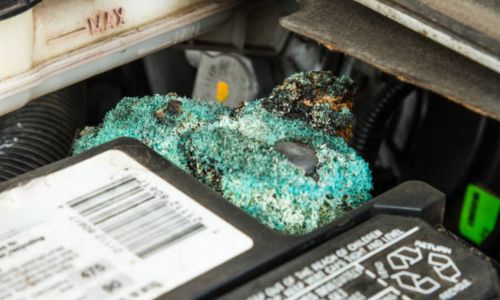Car battery corrosion can be a big problem. It can stop your car from starting and damage the battery. Cleaning it is not hard, but you need to know how to do it safely. This article will guide you on “how to clean a car battery corrosion” in simple steps. Understanding Car Battery Corrosion Before you start cleaning, it’s important to understand what car battery corrosion is. Corrosion usually looks like a white, ashy substance around the battery terminals. Sometimes, it can also be green or blue. This happens because of the chemical reactions inside the battery. When the battery acid leaks out, it reacts with the metal on the terminals, causing corrosion. Why Cleaning Car Battery Corrosion is Important Cleaning car battery corrosion is crucial for several reasons: Improves Battery Life: Corrosion can drain your battery power. Prevents Starting Problems: Corroded terminals can stop your car from starting. Safety: Corrosion can cause battery acid to leak, which is dangerous. Maintains Electrical Connections: Clean terminals ensure good electrical connections. Safety First: Precautions Before Cleaning Before you begin cleaning, follow these safety precautions: Wear Protective Gear: Use gloves and safety glasses to protect your hands and eyes. Work in a Ventilated Area: Battery fumes can be harmful, so working outside or in a well-ventilated garage is best. Turn Off the Car: Ensure the car is off and the keys are removed from the ignition. Disconnect the Battery: Disconnect the negative terminal to prevent any electrical short. Tools and Materials Needed Here is a list of tools and materials you will need: Gloves and safety glasses Baking soda Water A toothbrush or wire brush Wrench Clean cloth Petroleum jelly Step-by-Step Guide on How to Clean a Car Battery Corrosion Step 1: Locate the Battery First, open your car’s hood and locate the battery. Most batteries are in the engine compartment, but some might be in the trunk or under the rear seat. If you are unsure, check your car’s manual. Step 2: Inspect the Battery Look at the battery and the terminals to see where the corrosion is. Note the areas that need cleaning. Step 3: Disconnect the Battery Use a wrench to loosen the nut on the negative terminal (usually marked with a minus sign or black cover). Remove the cable and set it aside. Then, do the same for the positive terminal (marked with a plus sign or red cover). Step 4: Prepare a Cleaning Solution Mix baking soda with water to make a cleaning solution. A tablespoon of baking soda in a cup of water should be enough. Baking soda neutralizes the battery acid and helps remove corrosion. Step 5: Clean the Terminals Dip a toothbrush or wire brush into the baking soda solution. Scrub the corroded areas on the battery terminals and the cable ends. Be thorough but gentle to avoid damaging the terminals. Battery demand for vehicles in the United States grew by around 80%, despite electric car sales only increasing by around 55% in 2022. Step 6: Rinse with Water After scrubbing, pour a small amount of clean water over the terminals to rinse away the baking soda solution and loosen the corrosion. Step 7: Dry the Terminals Use a clean cloth to dry the battery terminals, and the cable ends thoroughly. Make sure everything is completely dry before reconnecting the battery. Step 8: Apply Petroleum Jelly Rub a small amount of petroleum jelly on the terminals. This helps prevent future corrosion by creating a barrier between the metal and the air. Step 9: Reconnect the Battery Reconnect the battery, starting with the positive terminal. Tighten the nut with the wrench. Then, reconnect the negative terminal and tighten it. Step 10: Test Your Car Start your car to ensure everything is working properly. If the car starts without issues, you’ve successfully cleaned the battery corrosion. Tips to Prevent Future Corrosion Regular Inspections: Check your battery terminals regularly for signs of corrosion. Use Battery Terminal Protectors: These are special washers treated with anti-corrosion chemicals. Keep Battery Clean: Wipe down the battery and terminals periodically. Secure the Battery: Ensure the battery is properly mounted to avoid vibrations that can cause leaks. Consider a Maintenance-Free Battery: These batteries are sealed and less prone to leaking. Signs You Need a New Battery Sometimes, cleaning corrosion is not enough. Here are signs that you might need a new battery: Your car has trouble starting even after cleaning the terminals. The battery is more than three years old. There is a visible crack or leak in the battery casing. The battery fails a load test. When to Seek Professional Help While cleaning car battery corrosion is a simple task, there are times when professional help is needed: Severe Corrosion: If the corrosion is very heavy and you cannot remove it, a mechanic might be able to help. Battery Damage: If you see any damage to the battery itself, it’s best to have it checked by a professional. Recurrent Problems: If you clean the terminals but they corrode again quickly, there might be an underlying issue with your car’s electrical system. Conclusion Knowing how to clean car battery corrosion is essential for every car owner. It ensures that your car runs smoothly and safely. Following the steps outlined in this guide, you can easily clean your car battery and prevent future corrosion. Remember always to take safety precautions and use the right tools. Regular maintenance and inspections will help keep your car battery in good condition, extending its life and improving your vehicle’s reliability. Technical FAQs on How to Clean a Car Battery Corrosion Q.1 How often should I check and clean my car battery for corrosion? Regular maintenance is key to preventing corrosion. Check your battery every few months, especially if you notice any starting issues or electrical problems. Cleaning should be done as needed, typically every 6-12 months. Q.2 What are some alternative methods to clean car battery corrosion? While baking soda and water is a common and effective

